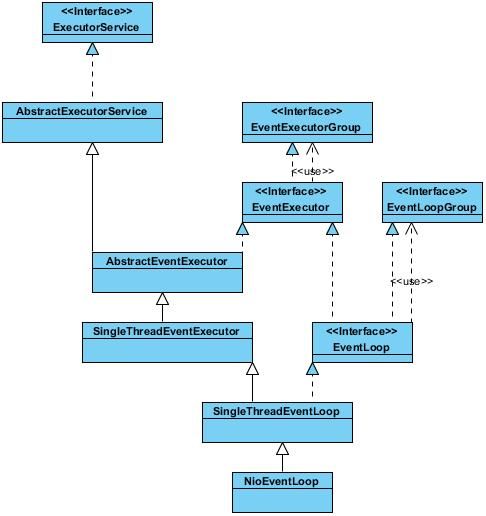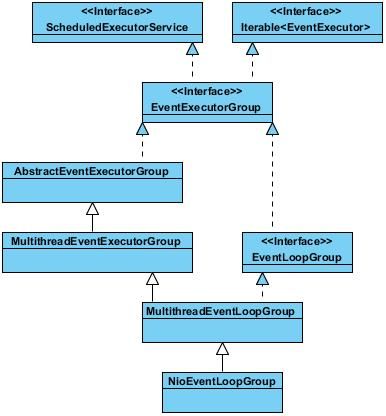本文为原创,转载请注明出处
netty4服务端启动源码分析-线程的创建
本文分析Netty中boss和worker的线程的创建过程:
以下代码是服务端的启动代码,线程的创建就发生在其中。
EventLoopGroup bossGroup = new NioEventLoopGroup();
NioEventLoopGroup的类关系图如下:
// NioEventLoopGroup
public NioEventLoopGroup() {
this(0);
}
public NioEventLoopGroup(int nThreads) {
this(nThreads, null);
}
public NioEventLoopGroup(int nThreads, ThreadFactory threadFactory) {
this(nThreads, threadFactory, SelectorProvider.provider());
}
public NioEventLoopGroup(
int nThreads, ThreadFactory threadFactory, final SelectorProvider selectorProvider) {
super(nThreads, threadFactory, selectorProvider);
}
看下父类MultithreadEventLoopGroup的构造方法
// MultithreadEventLoopGroup
protected MultithreadEventLoopGroup(int nThreads, ThreadFactory threadFactory, Object... args) {
super(nThreads == 0? DEFAULT_EVENT_LOOP_THREADS : nThreads, threadFactory, args);
}
注:如果没有指定创建的线程数量,则默认创建的线程个数为DEFAULT_EVENT_LOOP_THREADS,该数值为:处理器数量x2
再来看MultithreadEventLoopGroup的父类MultithreadEventExecutorGroup的构造方法
/**
* Create a new instance.
*
* @param nThreads the number of threads that will be used by this instance.
* @param threadFactory the ThreadFactory to use, or {@code null} if the default should be used.
* @param args arguments which will passed to each {@link #newChild(ThreadFactory, Object...)} call
*/
protected MultithreadEventExecutorGroup(int nThreads, ThreadFactory threadFactory, Object... args) {
if (nThreads <= 0) {
throw new IllegalArgumentException(String.format("nThreads: %d (expected: > 0)", nThreads));
}
if (threadFactory == null) {
threadFactory = newDefaultThreadFactory();
}
children = new SingleThreadEventExecutor[nThreads];
for (int i = 0; i < nThreads; i ++) {
boolean success = false;
try {
children[i] = newChild(threadFactory, args);
success = true;
} catch (Exception e) {
// TODO: Think about if this is a good exception type
throw new IllegalStateException("failed to create a child event loop", e);
} finally {
if (!success) {
for (int j = 0; j < i; j ++) {
children[j].shutdownGracefully();
}
for (int j = 0; j < i; j ++) {
EventExecutor e = children[j];
try {
while (!e.isTerminated()) {
e.awaitTermination(Integer.MAX_VALUE, TimeUnit.SECONDS);
}
} catch (InterruptedException interrupted) {
Thread.currentThread().interrupt();
break;
}
}
}
}
}
final FutureListener<Object> terminationListener = new FutureListener<Object>() {
@Override
public void operationComplete(Future<Object> future) throws Exception {
if (terminatedChildren.incrementAndGet() == children.length) {
terminationFuture.setSuccess(null);
}
}
};
for (EventExecutor e: children) {
e.terminationFuture().addListener(terminationListener);
}
}
变量children就是用来存放创建的线程的数组,里面每一个元素都通过children[i] = newChild(threadFactory, args)创建。而newChild方法则由子类NioEventLoopGroup实现
// NioEventLoopGroup
protected EventExecutor newChild(
ThreadFactory threadFactory, Object... args) throws Exception {
return new NioEventLoop(this, threadFactory, (SelectorProvider) args[0]);
}
每个元素的真实类型为NioEventLoop,而NioEventLoop的类关系图如下

(注:其实有点变态的,譬如EventLoop继承EventLoopGroup,不知道是啥原因,仅仅是因为EventLoop里有个方法parent(),返回EventLoopGroup这个功能吗?后续待确认)
接着看NioEventLoop的构造函数:
// NioEventLoop
NioEven NioEventLoop tLoop(NioEventLoopGroup parent, ThreadFactory threadFactory, SelectorProvider selectorProvider) {
super(parent, threadFactory, false);
if (selectorProvider == null) {
throw new NullPointerException("selectorProvider");
}
provider = selectorProvider;
selector = openSelector();
}
首先分析一下selector = openSelector()
// NioEventLoop
private Selector openSelector() {
final Selector selector;
try {
selector = provider.openSelector();
} catch (IOException e) {
throw new ChannelException("failed to open a new selector", e);
}
if (DISABLE_KEYSET_OPTIMIZATION) {
return selector;
}
try {
SelectedSelectionKeySet selectedKeySet = new SelectedSelectionKeySet();
Class<?> selectorImplClass =
Class.forName("sun.nio.ch.SelectorImpl", false, ClassLoader.getSystemClassLoader());
selectorImplClass.isAssignableFrom(selector.getClass());
Field selectedKeysField = selectorImplClass.getDeclaredField("selectedKeys");
Field publicSelectedKeysField = selectorImplClass.getDeclaredField("publicSelectedKeys");
selectedKeysField.setAccessible(true);
publicSelectedKeysField.setAccessible(true);
selectedKeysField.set(selector, selectedKeySet);
publicSelectedKeysField.set(selector, selectedKeySet);
selectedKeys = selectedKeySet;
logger.trace("Instrumented an optimized java.util.Set into: {}", selector);
} catch (Throwable t) {
selectedKeys = null;
logger.trace("Failed to instrument an optimized java.util.Set into: {}", selector, t);
}
return selector;
}
这里对sun.nio.ch.SelectorImpl中的selectedKeys和publicSelectedKeys做了优化,NioEventLoop中的变量selectedKeys的类型是SelectedSelectionKeySet,有哪些优化呢?(内部用两个数组存储?初始分配数组大小置为1024避免频繁扩容?当大小超过1024时,对数组进行双倍扩容?)。
利用反射,当注册到selector中的selectionKey已准备就绪时,selectedKeys中的元素就不会为空,后面会根据selectedKeys进行分发。
最后分析super(parent, threadFactory, false),即父类SingleThreadEventExecutor的构造函数
/**
* Create a new instance
*
* @param parent the {@link EventExecutorGroup} which is the parent of this instance and belongs to it
* @param threadFactory the {@link ThreadFactory} which will be used for the used {@link Thread}
* @param addTaskWakesUp {@code true} if and only if invocation of {@link #addTask(Runnable)} will wake up the
* executor thread
*/
protected SingleThreadEventExecutor(
EventExecutorGroup parent, ThreadFactory threadFactory, boolean addTaskWakesUp) {
if (threadFactory == null) {
throw new NullPointerException("threadFactory");
}
this.parent = parent;
this.addTaskWakesUp = addTaskWakesUp;
thread = threadFactory.newThread(new Runnable() {
@Override
public void run() {
boolean success = false;
updateLastExecutionTime();
try {
SingleThreadEventExecutor.this.run();
success = true;
} catch (Throwable t) {
logger.warn("Unexpected exception from an event executor: ", t);
} finally {
if (state < ST_SHUTTING_DOWN) {
state = ST_SHUTTING_DOWN;
}
// Check if confirmShutdown() was called at the end of the loop.
if (success && gracefulShutdownStartTime == 0) {
logger.error(
"Buggy " + EventExecutor.class.getSimpleName() + " implementation; " +
SingleThreadEventExecutor.class.getSimpleName() + ".confirmShutdown() must be called " +
"before run() implementation terminates.");
}
try {
// Run all remaining tasks and shutdown hooks.
for (;;) {
if (confirmShutdown()) {
break;
}
}
} finally {
try {
cleanup();
} finally {
synchronized (stateLock) {
state = ST_TERMINATED;
}
threadLock.release();
if (!taskQueue.isEmpty()) {
logger.warn(
"An event executor terminated with " +
"non-empty task queue (" + taskQueue.size() + ')');
}
terminationFuture.setSuccess(null);
}
}
}
}
});
taskQueue = newTaskQueue();
}
/**
* Create a new {@link Queue} which will holds the tasks to execute. This default implementation will return a
* {@link LinkedBlockingQueue} but if your sub-class of {@link SingleThreadEventExecutor} will not do any blocking
* calls on the this {@link Queue} it may make sense to {@code @Override} this and return some more performant
* implementation that does not support blocking operations at all.
*/
protected Queue<Runnable> newTaskQueue() {
return new LinkedBlockingQueue<Runnable>();
}
boss线程就在此处创建:thread = threadFactory.newThread(new Runnable()
同时也创建了线程的任务队列,是一个LinkedBlockingQueue结构。
SingleThreadEventExecutor.this.run()由子类NioEventLoop实现,后面的文章再进行分析
总结:
EventLoopGroup bossGroup = new NioEventLoopGroup()发生了以下事情:
1、 为NioEventLoopGroup创建数量为:处理器个数 x 2的,类型为NioEventLoop的实例。每个NioEventLoop实例 都持有一个线程,以及一个类型为LinkedBlockingQueue的任务队列
2、线程的执行逻辑由NioEventLoop实现
3、每个NioEventLoop实例都持有一个selector,并对selector进行优化。
